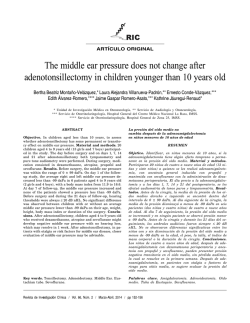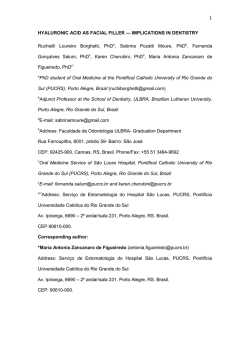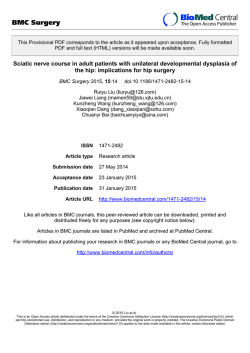
Middle Ear Actinomycosis Involving Facial Nerve and Lateral
online © ML Comm Korean J Otorhinolaryngol-Head Neck Surg 2015;58(1):57-60 / pISSN 2092-5859 / eISSN 2092-6529 Case Report http://dx.doi.org/10.3342/kjorl-hns.2015.58.1.57 Middle Ear Actinomycosis Involving Facial Nerve and Lateral Semicircular Canal Sungsu Lee, Hyong-Joo Park, and Hyong-Ho Cho Department of Otolaryngology-Head and Neck Surgery, Chonnam National University Medical School, Gwangju, Korea 안면신경과 외측반고리관을 침범한 중이 방선균증 이성수·박형주·조형호 전남대학교 의과대학 이비인후과학교실 Received May 12, 2014 Revised July 14, 2014 Accepted July 15, 2014 Address for correspondence Hyong-Ho Cho, MD, PhD Department of Otolaryngology-Head and Neck Surgery, Chonnam National University Medical School, 42 Jebong-ro, Dong-gu, Gwangju 501-757, Korea Tel +82-62-220-6776 Fax +82-62-228-7743 E-mail [email protected] Actinomycosis is a chronic granulomatous disease caused by the species of Actinomyces. Although it has become a rare disease in the present antibiotics era, it still needs long term antibiotic treatment and often mis- or delayed- diagnosed due to no typical sign and symptoms. Most often, it occurs in the cervicofacial region. Middle ear is not a common site for Actinomycosis, and the inner ear involvement is extremely rare. Here, we report a case of middle ear Actinomycosis involving facial nerve and lateral semicircular canal. Korean J Otorhinolaryngol-Head Neck Surg 2015;58(1):57-60 Key WordsZZActinomycosisㆍFacial nerveㆍLateral semicircular canalㆍMiddle earㆍ Temporal bone. Introduction Case Actinomycosis is a chronic granulomatous contagious disease, caused by Actinomyces, a slow growing, anaerobic, gram-positive, non acid-fast, filamentous bacterium. Actinomyces species are commensal flora of the oropharynx, gastrointestinal tract and female genital tract in human. It was once a fatal disease, however in the antibiotic era, it is well cured by most of the antibiotic treatment. Still, Actinomycosis usually needs open biopsy for confirm diagnosis and requires long term antibiotics administration. It often mimics tumor or fistula tract with swollen mass or draining sinus respectively. Most infection are cervicofacial, followed by thoracic and abdominal area.1) Actinomycosis occurring in middle ear is rare, and moreover, there was only one report with inner ear involvement. Here, we report the second worldwide case of middle ear Actinomycosis involving facial nerve and labyrinth. A 60-year-old female patient presented our hospital with acute left facial paralysis symptom. She was taking medication for hypertension, otherwise her past history was nonspecific. She had left side impaired hearing and left otorrhea for 3 years. Then 3 days previously, left otalgia and left facial paralysis with House-Brackmann (HB) grade IV occurred. She also complained of intermittent dizziness, however nystagmus was absent. No other cranial nerve was involved. Her left eardrum was bulged with purulent pulsating discharge (Fig. 1). Pus culture and temporal bone CT was done. Candida albicans was noted in pus culture. Temporal bone CT demonstrated complete opacification of the left middle ear cavity and mastoid (Fig. 2A). Ossicular erosion and lateral semicircular canal bony dehiscence were also noted. Pure tone audiogram showed total deafness on the left side, whereas right side normal. With the impression of left chronic otitis media with com- Copyright © 2015 Korean Society of Otorhinolaryngology-Head and Neck Surgery 57 Korean J Otorhinolaryngol-Head Neck Surg █ 2015;58(1):57-60 plicated facial nerve palsy, she underwent canal wall down mastoidectomy, tympanoplasty and facial nerve decompression. Intra-operative finding showed thick granulation tissue Fig. 1. Left ear drum showing postero-superior bulging with purulent discharge. Fig. 2. Pre-operative (A) and 6 month’s post-operative (B) temporal bone CT scan. A complete soft tissue opacification is noted in middle ear cavity and mastoid. Also an ossicular erosion (black arrowhead) and bony dehiscence of the lateral semicircular canal are shown (black arrow) (A). A well aerated middle ear cavity lateral to facial nerve tympanic segment is seen post-operatively (*) (B). Fig. 3. Intra-operative findings. Thick granulation tissue covering the facial nerve was noted (black arrowhead) (A). After removing the granulation tissue, facial nerve tympanic segment with bony dehiscence was seen (black arrow). The stapes superstructure was intact (*) (B). 58 filling the middle ear cavity (Fig. 3A). Malleus and incus were almost totally eroded. Stapes was preserved with intact superstructure. Focal dehiscence covered by granulation tissue was noted at the tympanic segment of facial nerve (Fig. 3B). Granulation tissue was gently removed from the facial nerve. Lateral semicircular canal appeared as a blue line suggesting that the membranous labyrinth was intact. Bony dehiscence was reinforced with perichondrium. Post wall of external auditory canal was reconstructed with anterior based musculoperiosteal flap. The day after the operation, left facial paralysis was HB grade III, further more improving to grade II a week later. Final biopsy revealed to be Actinomycosis with ‘sulfur granule’ formation (Fig. 4). Together with high dosage of steroid due to facial palsy, intravenous ceftriaxone (2 g/day) was administered for a week and then oral cefcapene (300 mg/day) was given for 6 months postoperatively. The facial paralysis was completely recovered to normal after 1 month. After 6 months, dizziness was absent and facial nerve function remained to be intact. Her neodrum was intact and A B A B Actinomycosis Involving Facial Nerve and Lateral Semicircular Canal █ Lee S, et al. Fig. 4. Hematoxylin & eosin staining demonstrates sulfur granule. Cauliflower like appearance consist of clump of filamentous micro-organisms and polymorphonuclear neutrophils are seen. This is a pathognomonic finding of Actinomycosis (×200). follow up temporal bone CT showed aeration in middle ear with no evidence of recurrence (Fig. 2B). Discussion Among 14 Actinomyces genus, 6 bacilli such as Actinomyces israelii, Actinomyces naeslundii are known to cause infection in human body. This species was first described as a human pathogen by Israel in year 1878. It was once a fatal disease in the pre-antibiotic era, with reports of 62% mortality.2) Actinomyces itself has low pathogenicity and is a normal flora in oral, gastrointestinal and female genital tracts.1) It is characteristically spread by direct invasion through mucosal injury due to as trauma, dental cares, tooth extraction, surgery or preceding infection.1) Consequently, the most common site of the infection is cervicofacial, especially around the mandible, followed by thoracic and abdominal region in immunocompetent patient.3) Middle ear is a rare site for Actinomycosis, as recently reviewed that in the antibiotic era, only 26 cases were reported in English written literature.4) It can occur in any ages, most frequently infecting young to middleaged adult.3,5) It seems that this tendency is somewhat younger in middle ear Actinomycosis. It has been shown that more than half of the middle ear Actinomycosis occurred at the age under 15.4,6) This might have been due to that children are prone to ascending infection through Eustachian tube.7) Diagnosis of Actinomycosis is rather challenging because it has no typical sign or symptoms. In cervicofacial infection, patient frequently present with chronic swelling8) and is often misdiagnosed as malignancy. Actinomycosis in the mid- dle ear shows chronic intermittent otorrhea most commonly.6) As in our case, ear drum is usually bulged with or without perforation. Hearing impairment can occur in several degree. In present case, the patient was totally deaf, with ossicle erosion and labyrinth involvement. Combined facial nerve palsy was reported only in one case worldwidely.7) In that report, the patient was 11 year old boy with facial weakness HB grade V. After operation and 6 month’s antibiotics treatment, the final outcome was HB grade II. In our case it was 60 year old female with initial grade VI. Fortunately, after 6 month’s treatment it was completely recovered. Culture of Actinomycosis may not be useful due to false negative ratio up to 70%. Instead, other micro-organism can be co-infected and detected like Fusobacterium, Bacteroides, Haemophilus, Eikennella, Staphylococcus, Streptococcus, Gemella, Neisseria and Eubacterium.9) These co-pathogen can facilitate mucosal penetration and spread of Actinomyces. Candida albicans was noted in our case. Confirm diagnosis usually needs soft tissue biopsy. Typically ‘sulfur granule’ is noted in Actinomycosis. Sulfur granule is a clump of filamentous actinomycete colonies with polymorphonuclear neutrophils. Sulfur granules are nearly pathognomonic for Actinomycosis, although Nocardia can also form it.10) Nocardia can be distinguished from Actinomycosis since Nocardia is fast growing and positive for acid-fast staining. Standard treatment of Actinomycosis is surgical debridement with long-term antibiotics administration.6) Debridement is need for disease removal as well as for diagnosis. As in our case, thick granulation tissue can be encountered during the operation in middle ear Actinomycosis. It has been suggested that this granulation provides anaerobic environment for the Actinomyces.11) Actinomyces is susceptible to many antibiotics, still, penicillin is the first line drug. Usually antibiotics regimen consist of 2-4 weeks high dose intravenous (iv) administration followed by 6 to 12 months per-oral antibiotics.1) In the present case, the infection was successfully cured with tympanomastoidectomy and a week ceftriaxone iv followed by 6 months’ oral cefcapene. Acknowledgments The authors thank E. M. Park and Y. H. Choi for expert technical assistance. We gratefully acknowledge supports from the institute for this study. REFERENCES 1) Reichenbach J, Lopatin U, Mahlaoui N, Beovic B, Siler U, Zbinden R, et al. Actinomyces in chronic granulomatous disease: an emerging and unanticipated pathogen. Clin Infect Dis 2009;49(11):1703-10. www.jkorl.org 59 Korean J Otorhinolaryngol-Head Neck Surg █ 2015;58(1):57-60 2) Harvey JC, Cantrell JR, Fisher AM. Actinomycosis: its recognition and treatment. Ann Intern Med 1957;46(5):868-85. 3) Moghimi M, Salentijn E, Debets-Ossenkop Y, Karagozoglu KH, Forouzanfar T. Treatment of cervicofacial actinomycosis: a report of 19 cases and review of literature. Med Oral Patol Oral Cir Bucal 2013;18(4):e627-32. 4) Kullar PJ, Yates P. Actinomycosis of the middle ear. J Laryngol Otol 2013;127(7):712-5. 5) Weese WC, Smith IM. A study of 57 cases of actinomycosis over a 36-year period. A diagnostic ‘failure’ with good prognosis after treatment. Arch Intern Med 1975;135(12):1562-8. 6) Budenz CL, Tajudeen BA, Roehm PC. Actinomycosis of the temporal bone and brain: case report and review of the literature. Ann Otol 60 Rhinol Laryngol 2010;119(5):313-8. 7) Mehta D, Statham M, Choo D. Actinomycosis of the temporal bone with labyrinthine and facial nerve involvement. Laryngoscope 2007; 117(11):1999-2001. 8) Wong VK, Turmezei TD, Weston VC. Actinomycosis. BMJ 2011; 343:d6099. 9) Lee JP, Rudoy R. Pediatric thoracic actinomycosis. Hawaii Med J 2003;62(2):30-2. 10) Shishegar M, Hosseini SH, Varedi P, Varedi P, Mahmoodi S, Ashraf MJ, et al. Actinomycosis of the middle ear. Otol Neurotol 2009;30(5): 686-7. 11) Townrow V, Barrie HJ. Fatal Actinomyces infection of the middle ear. J Laryngol Otol 1945;60:329.
© Copyright 2026









